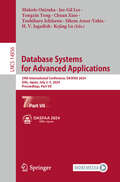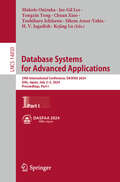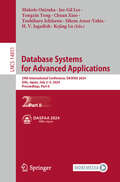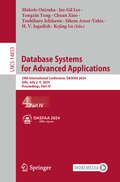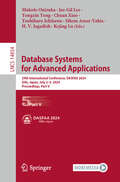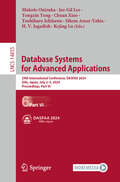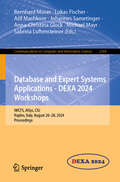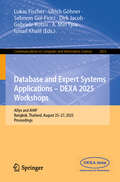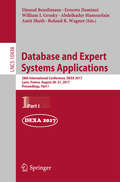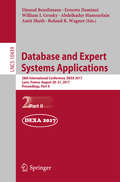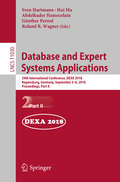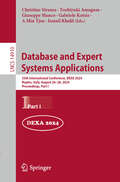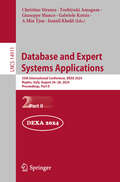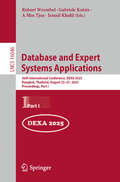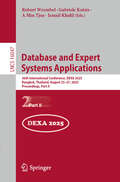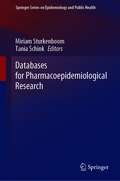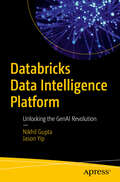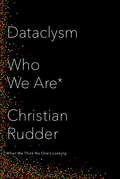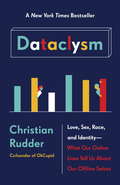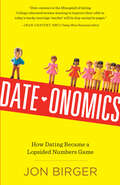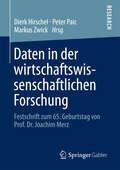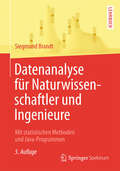- Table View
- List View
Database Systems for Advanced Applications: 29th International Conference, DASFAA 2024, Gifu, Japan, July 2-5, 2024, Proceedings, Part VII (Lecture Notes in Computer Science #14856)
by Yoshiharu Ishikawa Yongxin Tong Jae-Gil Lee Chuan Xiao Sihem Amer-Yahia Makoto Onizuka H. V. Jagadish Kejing LuThe seven-volume set LNCS 14850-14856 constitutes the proceedings of the 29th International Conference on Database Systems for Advanced Applications, DASFAA 2024, held in Gifu, Japan, in July 2024. The total of 147 full papers, along with 85 short papers, presented together in this seven-volume set was carefully reviewed and selected from 722 submissions. Additionally, 14 industrial papers, 18 demo papers and 6 tutorials are included. The conference presents papers on subjects such as: Part I: Spatial and temporal data; database core technology; federated learning. Part II: Machine learning; text processing. Part III: Recommendation; multi-media. Part IV: Privacy and security; knowledge base and graphs. Part V: Natural language processing; large language model; time series and stream data. Part VI: Graph and network; hardware acceleration. Part VII: Emerging application; industry papers; demo papers.
Database Systems for Advanced Applications: 29th International Conference, DASFAA 2024, Gifu, Japan, July 2–5, 2024, Proceedings, Part I (Lecture Notes in Computer Science #14850)
by Yoshiharu Ishikawa Yongxin Tong Jae-Gil Lee Chuan Xiao Sihem Amer-Yahia Makoto Onizuka H. V. Jagadish Kejing LuThe seven-volume set LNCS 14850-14856 constitutes the proceedings of the 29th International Conference on Database Systems for Advanced Applications, DASFAA 2024, held in Gifu, Japan, in July 2024. The total of 147 full papers, along with 85 short papers, presented together in this seven-volume set was carefully reviewed and selected from 722 submissions. Additionally, 14 industrial papers, 18 demo papers and 6 tutorials are included. The conference presents papers on subjects such as: Part I: Spatial and temporal data; database core technology; federated learning. Part II: Machine learning; text processing. Part III: Recommendation; multi-media. Part IV: Privacy and security; knowledge base and graphs. Part V: Natural language processing; large language model; time series and stream data. Part VI: Graph and network; hardware acceleration. Part VII: Emerging application; industry papers; demo papers.
Database Systems for Advanced Applications: 29th International Conference, DASFAA 2024, Gifu, Japan, July 2–5, 2024, Proceedings, Part II (Lecture Notes in Computer Science #14851)
by Yoshiharu Ishikawa Yongxin Tong Jae-Gil Lee Chuan Xiao Sihem Amer-Yahia Makoto Onizuka H. V. Jagadish Kejing LuThe seven-volume set LNCS 14850-14856 constitutes the proceedings of the 29th International Conference on Database Systems for Advanced Applications, DASFAA 2024, held in Gifu, Japan, in July 2024. The total of 147 full papers, along with 85 short papers, presented together in this seven-volume set was carefully reviewed and selected from 722 submissions. Additionally, 14 industrial papers, 18 demo papers and 6 tutorials are included. The conference presents papers on subjects such as: Part I: Spatial and temporal data; database core technology; federated learning. Part II: Machine learning; text processing. Part III: Recommendation; multi-media. Part IV: Privacy and security; knowledge base and graphs. Part V: Natural language processing; large language model; time series and stream data. Part VI: Graph and network; hardware acceleration. Part VII: Emerging application; industry papers; demo papers.
Database Systems for Advanced Applications: 29th International Conference, DASFAA 2024, Gifu, Japan, July 2–5, 2024, Proceedings, Part III (Lecture Notes in Computer Science #14852)
by Yoshiharu Ishikawa Yongxin Tong Jae-Gil Lee Chuan Xiao Sihem Amer-Yahia Makoto Onizuka H. V. Jagadish Kejing LuThe seven-volume set LNCS 14850-14856 constitutes the proceedings of the 29th International Conference on Database Systems for Advanced Applications, DASFAA 2024, held in Gifu, Japan, in July 2024. The total of 147 full papers, along with 85 short papers, presented together in this seven-volume set was carefully reviewed and selected from 722 submissions. Additionally, 14 industrial papers, 18 demo papers and 6 tutorials are included. The conference presents papers on subjects such as: Part I: Spatial and temporal data; database core technology; federated learning. Part II: Machine learning; text processing. Part III: Recommendation; multi-media. Part IV: Privacy and security; knowledge base and graphs. Part V: Natural language processing; large language model; time series and stream data. Part VI: Graph and network; hardware acceleration. Part VII: Emerging application; industry papers; demo papers.
Database Systems for Advanced Applications: 29th International Conference, DASFAA 2024, Gifu, Japan, July 2–5, 2024, Proceedings, Part IV (Lecture Notes in Computer Science #14853)
by Yoshiharu Ishikawa Yongxin Tong Jae-Gil Lee Chuan Xiao Sihem Amer-Yahia Makoto Onizuka H. V. Jagadish Kejing LuThe seven-volume set LNCS 14850-14856 constitutes the proceedings of the 29th International Conference on Database Systems for Advanced Applications, DASFAA 2024, held in Gifu, Japan, in July 2024. The total of 147 full papers, along with 85 short papers, presented together in this seven-volume set was carefully reviewed and selected from 722 submissions. Additionally, 14 industrial papers, 18 demo papers and 6 tutorials are included. The conference presents papers on subjects such as: Part I: Spatial and temporal data; database core technology; federated learning. Part II: Machine learning; text processing. Part III: Recommendation; multi-media. Part IV: Privacy and security; knowledge base and graphs. Part V: Natural language processing; large language model; time series and stream data. Part VI: Graph and network; hardware acceleration. Part VII: Emerging application; industry papers; demo papers.
Database Systems for Advanced Applications: 29th International Conference, DASFAA 2024, Gifu, Japan, July 2–5, 2024, Proceedings, Part V (Lecture Notes in Computer Science #14854)
by Yoshiharu Ishikawa Yongxin Tong Jae-Gil Lee Chuan Xiao Sihem Amer-Yahia Makoto Onizuka H. V. Jagadish Kejing LuThe seven-volume set LNCS 14850-14856 constitutes the proceedings of the 29th International Conference on Database Systems for Advanced Applications, DASFAA 2024, held in Gifu, Japan, in July 2024. The total of 147 full papers, along with 85 short papers, presented together in this seven-volume set was carefully reviewed and selected from 722 submissions. Additionally, 14 industrial papers, 18 demo papers and 6 tutorials are included. The conference presents papers on subjects such as: Part I: Spatial and temporal data; database core technology; federated learning. Part II: Machine learning; text processing. Part III: Recommendation; multi-media. Part IV: Privacy and security; knowledge base and graphs. Part V: Natural language processing; large language model; time series and stream data. Part VI: Graph and network; hardware acceleration. Part VII: Emerging application; industry papers; demo papers.
Database Systems for Advanced Applications: 29th International Conference, DASFAA 2024, Gifu, Japan, July 2–5, 2024, Proceedings, Part VI (Lecture Notes in Computer Science #14855)
by Yoshiharu Ishikawa Yongxin Tong Jae-Gil Lee Chuan Xiao Sihem Amer-Yahia Makoto Onizuka H. V. Jagadish Kejing LuThe seven-volume set LNCS 14850-14856 constitutes the proceedings of the 29th International Conference on Database Systems for Advanced Applications, DASFAA 2024, held in Gifu, Japan, in July 2024. The total of 147 full papers, along with 85 short papers, presented together in this seven-volume set was carefully reviewed and selected from 722 submissions. Additionally, 14 industrial papers, 18 demo papers and 6 tutorials are included. The conference presents papers on subjects such as: Part I: Spatial and temporal data; database core technology; federated learning. Part II: Machine learning; text processing. Part III: Recommendation; multi-media. Part IV: Privacy and security; knowledge base and graphs. Part V: Natural language processing; large language model; time series and stream data. Part VI: Graph and network; hardware acceleration. Part VII: Emerging application; industry papers; demo papers.
Database and Expert Systems Applications - DEXA 2024 Workshops: IWCFS, AISys, CIU, Naples, Italy, August 26–28, 2024, Proceedings (Communications in Computer and Information Science #2169)
by Atif Mashkoor Johannes Sametinger Bernhard Moser Lukas Fischer Anna-Christina Glock Michael Mayr Sabrina LuftensteinerThis volume constitutes the refereed proceedings of the workshops held at the 35th International Conference on Database and Expert Systems Applications, DEXA 2024, which took place in Naples, Italy, in August 2024. The papers included in this book stem from the following workshops: - 9th International Workshop on Cyber-Security and Functional Safety inCyber-Physical Systems (IWCFS 2024), - 4th International Workshop on AI SystemEngineering: Math, Modelling and Software (AISys 2024), - 2nd InternationalWorkshop on Certainty in Uncertainty: Exploring Probabilistic Approaches in AI (CIU2024) The 10 full papers and 5 short papers were thoroughly reviewed and selected from a total of 24 submissions. They were organized in topical sections as follows: Cyber-security and functional safety in cyber-physical systems; AI system engineering: math, modelling, and software; certainty in uncertainty: exploring probabilistic approaches in AI.
Database and Expert Systems Applications - DEXA 2025 Workshops: AISys and AI4IP, Bangkok, Thailand, August 25–27, 2025, Proceedings (Communications in Computer and Information Science #2615)
by Ismail Khalil A Min Tjoa Gabriele Kotsis Lukas Fischer Ulrich Göhner Sebnem Gül-Ficici Dirk JacobThis volume constitutes the refereed proceedings of the 7th International Workshop on AI System Engineering: Math, Modelling and Software, AISys 2025 and the First International Workshop on Optimisation of Industrial Production with AI Algorithms, AI4IP, co-located with the 36th International Conference on Database and Expert Systems Applications, DEXA 2025, which took place in Bangkok, Thailand, during August 25-27, 2025.The 11 full papers were thoroughly reviewed and selected from a total of 23 submissions. They are organized in topical sections as follows: AI System Engineering: Math, Modelling and Software; and Optimization of Industrial Production with AI Algorithms.
Database and Expert Systems Applications: 28th International Conference, DEXA 2017, Lyon, France, August 28-31, 2017, Proceedings, Part I (Lecture Notes in Computer Science #10438)
by Djamal Benslimane, Ernesto Damiani, William I. Grosky, Abdelkader Hameurlain, Amit Sheth and Roland R. WagnerThis two volume set LNCS 10438 and LNCS 10439 constitutes the refereed proceedings of the 28th International Conference on Database and Expert Systems Applications, DEXA 2017, held in Lyon, France, August 2017. The 37 revised full papers presented together with 40 short papers were carefully reviewed and selected from 166 submissions. The papers discuss a range of topics including: Semantic Web and Semantics; Graph Matching; Data Modeling, Data Abstraction, and Uncertainty; Preferences and Query Optimization; Data Integration and RDF Matching; Security and Privacy; Web Search; Data Clustering; Top-K and Skyline Queries; Data Mining and Big Data; Service Computing; Continuous and Temporal Data, and Continuous Query Language; Text Processing and Semantic Search; Indexing and Concurrency Control Methods; Data Warehouse and Data Stream Warehouse; Data Mining and Machine Learning; Recommender Systems and Query Recommendation; Graph Algorithms; Semantic Clustering and Data Classification.
Database and Expert Systems Applications: 28th International Conference, DEXA 2017, Lyon, France, August 28-31, 2017, Proceedings, Part II (Lecture Notes in Computer Science #10439)
by Djamal Benslimane, Ernesto Damiani, William I. Grosky, Abdelkader Hameurlain, Amit Sheth and Roland R. WagnerThis two volume set LNCS 10438 and LNCS 10439 constitutes the refereed proceedings of the 28th International Conference on Database and Expert Systems Applications, DEXA 2017, held in Lyon, France, August 2017. The 37 revised full papers presented together with 40 short papers were carefully reviewed and selected from 166 submissions. The papers discuss a range of topics including: Semantic Web and Semantics; Graph Matching; Data Modeling, Data Abstraction, and Uncertainty; Preferences and Query Optimization; Data Integration and RDF Matching; Security and Privacy; Web Search; Data Clustering; Top-K and Skyline Queries; Data Mining and Big Data; Service Computing; Continuous and Temporal Data, and Continuous Query Language; Text Processing and Semantic Search; Indexing and Concurrency Control Methods; Data Warehouse and Data Stream Warehouse; Data Mining and Machine Learning; Recommender Systems and Query Recommendation; Graph Algorithms; Semantic Clustering and Data Classification.
Database and Expert Systems Applications: 29th International Conference, DEXA 2018, Regensburg, Germany, September 3–6, 2018, Proceedings, Part II (Lecture Notes in Computer Science #11030)
by Abdelkader Hameurlain Sven Hartmann Hui Ma Günther Pernul Roland R. WagnerThis two volume set of LNCS 11029 and LNCS 11030 constitutes the refereed proceedings of the 29th International Conference on Database and Expert Systems Applications, DEXA 2018, held in Regensburg, Germany, in September 2018.The 35 revised full papers presented together with 40 short papers were carefully reviewed and selected from 160 submissions. The papers of the first volume discuss a range of topics including: Big data analytics; data integrity and privacy; decision support systems; data semantics; cloud data processing; time series data; social networks; temporal and spatial databases; and graph data and road networks. The papers of the second volume discuss a range of the following topics: Information retrieval; uncertain information; data warehouses and recommender systems; data streams; information networks and algorithms; database system architecture and performance; novel database solutions; graph querying and databases; learning; emerging applications; data mining; privacy; and text processing.
Database and Expert Systems Applications: 35th International Conference, DEXA 2024, Naples, Italy, August 26–28, 2024, Proceedings, Part I (Lecture Notes in Computer Science #14910)
by Giuseppe Manco Ismail Khalil A Min Tjoa Christine Strauss Gabriele Kotsis Toshiyuki AmagasaThe two-volume set LNCS 14910 and 14911 constitutes the proceedings of the 35th International Conference on Database and Expert Systems Applications, DEXA 2024, which took place in Naples, Italy, in August 2024. The 27 full and 20 short papers included in the proceedings set were carefully reviewed and selected from 102 submissions. They were organized in topical sections as follows: Part I: Financial and economic data analysis; graph theory and network analysis; database management and query optimization; machine learning and large language models; recommender systems and personalization; Part II: Blockchain and supply management; data mining and knowledge discovery; spatiotemporal data and mobility analysis; computer vision and image processing; data security and privacy; database indexing and query processing; specialized applications and case studies.
Database and Expert Systems Applications: 35th International Conference, DEXA 2024, Naples, Italy, August 26–28, 2024, Proceedings, Part II (Lecture Notes in Computer Science #14911)
by Giuseppe Manco Ismail Khalil A Min Tjoa Christine Strauss Gabriele Kotsis Toshiyuki AmagasaThe two-volume set LNCS 14910 and 14911 constitutes the proceedings of the 35th International Conference on Database and Expert Systems Applications, DEXA 2024, which took place in Naples, Italy, in August 2024. The 27 full and 20 short papers included in the proceedings set were carefully reviewed and selected from 102 submissions. They were organized in topical sections as follows: Part I: Financial and economic data analysis; graph theory and network analysis; database management and query optimization; machine learning and large language models; recommender systems and personalization; Part II: Blockchain and supply management; data mining and knowledge discovery; spatiotemporal data and mobility analysis; computer vision and image processing; data security and privacy; database indexing and query processing; specialized applications and case studies.
Database and Expert Systems Applications: 36th International Conference, DEXA 2025, Bangkok, Thailand, August 25–27, 2025, Proceedings, Part I (Lecture Notes in Computer Science #16046)
by Ismail Khalil A Min Tjoa Robert Wrembel Gabriele KotsisThe two-volume set LNCS 16046-16047 constitutes the proceedings of the 36th International Conference on Database and Expert Systems Applications, DEXA 2025, held in Bangkok, Thailand, in August 25–27, 2025. The 35 full and 22 short papers presented in this set together with 3 invited talks were carefully reviewed and selected from 123 submissions. They were organized in topical sections as follows: Part I: Industrial Keynote; Invited Talks; Large Language Models; Data Quality; Machine Learning /Artificial Intelligence Applications; Classification Techniques. Part II: Image Processing, Analytics, and Vision Systems; Recommender Techniques; Data Integration; Optimisation Methods; Graph Applications; Analytics; Security/Privacy; Benchmarks and Surveys.
Database and Expert Systems Applications: 36th International Conference, DEXA 2025, Bangkok, Thailand, August 25–27, 2025, Proceedings, Part II (Lecture Notes in Computer Science #16047)
by Ismail Khalil A Min Tjoa Robert Wrembel Gabriele KotsisThe two-volume set LNCS 16046-16047 constitutes the proceedings of the 36th International Conference on Database and Expert Systems Applications, DEXA 2025, held in Bangkok, Thailand, in August 25–27, 2025. The 35 full and 22 short papers presented in this set together with 3 invited talks were carefully reviewed and selected from 123 submissions. They were organized in topical sections as follows: Part I: Industrial Keynote; Invited Talks; Large Language Models; Data Quality; Machine Learning /Artificial Intelligence Applications; Classification Techniques. Part II: Image Processing, Analytics, and Vision Systems; Recommender Techniques; Data Integration; Optimisation Methods; Graph Applications; Analytics; Security/Privacy; Benchmarks and Surveys.
Databases for Pharmacoepidemiological Research (Springer Series on Epidemiology and Public Health)
by Miriam Sturkenboom Tania SchinkThis book allows readers to gain an in-depth understanding of the role of real-world data in pharmacoepidemiology, and highlights the strengths and limitations of the respective databases with regard to pharmacoepidemiological research. Over the past decade, the increasing use of real-world data in pharmacoepidemiological research has been accompanied by a growing recognition of the value of real-world evidence in clinical and regulatory decision-making. Electronic healthcare databases allow analyses of drug and vaccine utilization in routine care after approval, as well as investigations of their comparative effectiveness and safety. They are especially useful for the identification of rare risks and rare drug exposures over long periods of time, and as such sustainably extend the basis for drug safety research. This book provides an introduction to the role of real-world data in pharmacoepidemiological research and the main developments in the last 15 years. It also offers a comprehensive overview of the general classification characteristics of databases, together with their strengths and limitations, and a detailed description of 21 individual databases, written by professionals who work with or maintain them.
Databricks Data Intelligence Platform: Unlocking the GenAI Revolution
by Nikhil Gupta Jason YipThis book is your comprehensive guide to building robust Generative AI solutions using the Databricks Data Intelligence Platform. Databricks is the fastest-growing data platform offering unified analytics and AI capabilities within a single governance framework, enabling organizations to streamline their data processing workflows, from ingestion to visualization. Additionally, Databricks provides features to train a high-quality large language model (LLM), whether you are looking for Retrieval-Augmented Generation (RAG) or fine-tuning. Databricks offers a scalable and efficient solution for processing large volumes of both structured and unstructured data, facilitating advanced analytics, machine learning, and real-time processing. In today's GenAI world, Databricks plays a crucial role in empowering organizations to extract value from their data effectively, driving innovation and gaining a competitive edge in the digital age. This book will not only help you master the Data Intelligence Platform but also help power your enterprise to the next level with a bespoke LLM unique to your organization. Beginning with foundational principles, the book starts with a platform overview and explores features and best practices for ingestion, transformation, and storage with Delta Lake. Advanced topics include leveraging Databricks SQL for querying and visualizing large datasets, ensuring data governance and security with Unity Catalog, and deploying machine learning and LLMs using Databricks MLflow for GenAI. Through practical examples, insights, and best practices, this book equips solution architects and data engineers with the knowledge to design and implement scalable data solutions, making it an indispensable resource for modern enterprises. Whether you are new to Databricks and trying to learn a new platform, a seasoned practitioner building data pipelines, data science models, or GenAI applications, or even an executive who wants to communicate the value of Databricks to customers, this book is for you. With its extensive feature and best practice deep dives, it also serves as an excellent reference guide if you are preparing for Databricks certification exams. What You Will Learn Foundational principles of Lakehouse architecture Key features including Unity Catalog, Databricks SQL (DBSQL), and Delta Live Tables Databricks Intelligence Platform and key functionalities Building and deploying GenAI Applications from data ingestion to model serving Databricks pricing, platform security, DBRX, and many more topics Who This Book Is For Solution architects, data engineers, data scientists, Databricks practitioners, and anyone who wants to deploy their Gen AI solutions with the Data Intelligence Platform. This is also a handbook for senior execs who need to communicate the value of Databricks to customers. People who are new to the Databricks Platform and want comprehensive insights will find the book accessible.
Dataclysm
by Christian RudderProvocative, illuminating, and visually arresting, Dataclysm is a portrait of how big data reveals our essential selves--and a first look at a revolution in the making. What is the secret to a stable marriage? How many gay people are still in the closet? Do we truly live in a postracial society? Has Twitter made us dumber? These are just a few of the questions Christian Rudder answers in Dataclysm, a smart, funny, irreverent look at how we act when we think no one's looking. For centuries we've relied on polling or small-scale lab experiments to study human behavior. Today a new approach is possible. As we live more of our lives online, researchers can finally observe us directly, in vast numbers and without filters. Data scientists can quantify the formerly unquantifiable and show with unprecedented precision how we fight, how we age, how we love, and how we change. Our personal data has been used to spy on us, hire and fire us, and sell us stuff we don't need. InDataclysm, Rudder uses it to show us who we are as people. He reveals how Facebook "likes" can predict, with surprising accuracy, a person's sexual orientation and even intelligence; how attractive women receive exponentially more job interview requests; and why you have to have haters to be hot. He charts the rise and fall of America's most reviled word through Google Search and examines the new dynamics of collaborative rage on Twitter. He shows how people express themselves, both privately and publicly. What is the least Asian thing you can say? Do people bathe more in Vermont or New Jersey? What do black women think about Simon & Garfunkel? Hint: They don't think about Simon & Garfunkel. Rudder also tracks human migration in real time, showing how groups of people move from certain small towns to the same big cities across the globe. And he grapples with the challenge of maintaining privacy in a world where these explorations are possible.
Dataclysm: Love, Sex, Race, and Identity--What Our Online Lives Tell Us about Our Offline Selves
by Christian RudderAn audacious, irreverent investigation of human behavior--and a first look at a revolution in the making Our personal data has been used to spy on us, hire and fire us, and sell us stuff we don't need. In Dataclysm, Christian Rudder uses it to show us who we truly are. For centuries, we've relied on polling or small-scale lab experiments to study human behavior. Today, a new approach is possible. As we live more of our lives online, researchers can finally observe us directly, in vast numbers, and without filters. Data scientists have become the new demographers. In this daring and original book, Rudder explains how Facebook "likes" can predict, with surprising accuracy, a person's sexual orientation and even intelligence; how attractive women receive exponentially more interview requests; and why you must have haters to be hot. He charts the rise and fall of America's most reviled word through Google Search and examines the new dynamics of collaborative rage on Twitter. He shows how people express themselves, both privately and publicly. What is the least Asian thing you can say? Do people bathe more in Vermont or New Jersey? What do black women think about Simon & Garfunkel? (Hint: they don't think about Simon & Garfunkel.) Rudder also traces human migration over time, showing how groups of people move from certain small towns to the same big cities across the globe. And he grapples with the challenge of maintaining privacy in a world where these explorations are possible. Visually arresting and full of wit and insight, Dataclysm is a new way of seeing ourselves--a brilliant alchemy, in which math is made human and numbers become the narrative of our time.From the Hardcover edition.
Date-onomics: How Dating Became a Lopsided Numbers Game
by Jon BirgerIt’s not that he’s just not that into you—it’s that there aren’t enough of him. And the numbers prove it. Using a combination of demographics, statistics, game theory, and number-crunching, Date-onomics tells what every single, college-educated, heterosexual, looking-for-a-partner woman needs to know: The “man deficit” is real. It’s a fascinating, if sobering read, with two critical takeaways: One, it’s not you. Two, knowledge is power, so here’s what to do about it. The shortage of college-educated men is not just a big-city phenomenon frustrating women in New York and L.A. Among young college grads, there are four eligible women for every three men nationwide. This unequal ratio explains not only why it’s so hard to find a date, but a host of social issues, from the college hookup culture to the reason Salt Lake City is becoming the breast implant capital of America. Then there’s the math that says that a woman’s good looks can keep men from approaching her—particularly if they feel the odds aren’t in their favor. Fortunately, there are also solutions: what college to attend (any with strong sciences or math), where to hang out (in New York, try a fireman’s bar), where to live (Colorado, Seattle, “Man” Jose), and why never to shy away from giving an ultimatum.
Daten in der wirtschaftswissenschaftlichen Forschung: Festschrift zum 65. Geburtstag von Prof. Dr. Joachim Merz
by Dierk Hirschel Peter Paic Markus ZwickDaten sind in der wirtschaftswissenschaftliche Forschung von hoher Bedeutung. Mit der drastischen Steigerung der Leistungsfähigkeit der Informationstechnik ist es heute möglich, riesige Datenmengen und insbesondere Mikrodaten zu speichern und zu analysieren. Mit dem Sonderforschungsbereich 3 der Deutschen Forschungsgemeinschaft ,Mikroanalytische Grundlagen der Gesellschaftspolitik' begann in den achtziger Jahren des letzten Jahrhunderts das Mikrodatenzeitalter in Deutschland. Seitdem ist die Entwicklung der mikrodatenbasierten Forschung und Politikberatung rasant fortgeschritten. Hierbei hatte und hat der mit diesem Buch geehrte Joachim Merz einen erheblichen Anteil. Der vorliegende Band zeigt einen Ausschnitt des Erfolges dieser wissenschaftlichen Arbeiten. Wegbegleiter wie der eigene wissenschaftliche Nachwuchs geben in insgesamt 12 Beiträgen einen vertiefenden Einblick in den Stand der empirischen wirtschaftswissenschaftlichen Forschung und zeigen mögliche weitere Entwicklungstendenzen auf.
Daten- und Informationsqualität: Die Grundlage der Digitalisierung
by Knut Hildebrand Marcus Gebauer Michael MielkeDieses Buch war das erste deutsche Buch zum Thema Daten- und Informationsqualität und ist mittlerweile ein Klassiker. Es wurde für die sechste Auflage um neue Inhalte erweitert, aktualisiert und an zahlreichen Stellen überarbeitet. Von Wissenschaftlern und Praktikern geschrieben, präsentiert es den aktuellen Stand aus Forschung und Anwendung und ist somit ein Muss für alle IT-Profis.
Daten-Teams: Ein einheitliches Managementmodell für erfolgreiche, datenorientierte Teams
by Jesse AndersonErfahren Sie, wie Sie erfolgreiche Big-Data-Projekte durchführen, wie Sie Ihre Teams mit Ressourcen ausstatten und wie die Teams miteinander arbeiten sollten, um kosteneffizient zu sein. In diesem Buch werden die drei Teams vorgestellt, die für erfolgreiche Projekte erforderlich sind, und es wird erläutert, welche Aufgaben die einzelnen Teams haben.Die meisten Unternehmen scheitern mit Big-Data-Projekten, und der Misserfolg wird fast immer auf die verwendeten Technologien geschoben. Um erfolgreich zu sein, müssen sich Unternehmen sowohl auf die Technologie als auch auf das Management konzentrieren.Die Nutzung von Daten ist ein Teamsport. Es bedarf verschiedener Menschen mit unterschiedlichen Fähigkeiten, die alle zusammenarbeiten müssen, um etwas zu erreichen. Bei allen Projekten, mit Ausnahme der kleinsten, sollten die Mitarbeiter in mehreren Teams organisiert werden, um das Scheitern von Projekten und unzureichende Leistungen zu vermeiden.Dieses Buch konzentriert sich auf das Management. Vor einigen Jahren wurde wenig bis gar nicht über das Management von Big-Data-Projekten oder -Teams geschrieben oder gesprochen. Data Teams zeigt, warum Managementfehler die Ursache für so viele Projektmisserfolge sind und wie Sie solche Misserfolge in Ihrem Projekt proaktiv verhindern können.Was Sie lernen werdenEntdecken Sie die drei Teams, die Sie benötigen, um mit Big Data erfolgreich zu seinVerstehen, was ein Datenwissenschaftler ist und was ein Datenwissenschaftsteam tutVerstehen, was ein Data Engineer ist und was ein Data Engineering Team machtVerstehen, was ein Betriebsingenieur ist und was ein Betriebsteam tutWissen, wie sich die Teams und Titel unterscheiden und warum Sie alle drei Teams brauchenErkennen, welche Rolle das Unternehmen bei der Zusammenarbeit mit Datenteams spielt und wie der Rest der Organisation zu erfolgreichen Datenprojekten beiträgtFür wen dieses Buch gedacht istFührungskräfte aller Ebenen, einschließlich derjenigen, die über einige technische Fähigkeiten verfügen und ein Big-Data-Projekt in Angriff nehmen wollen oder bereits ein Big-Data-Projekt begonnen haben. Es ist besonders hilfreich für diejenigen, die Projekte haben, die nicht vorankommen und nicht wissen, warum, oder die an einer Konferenz teilgenommen oder über Big Data gelesen haben und nun damit beginnen, zu prüfen, was nötig ist, um ein Projekt zu realisieren.Dieses Buch ist auch für leitende Mitarbeiter oder technische Architekten relevant, die in einem Team arbeiten, das vom Unternehmen beauftragt wurde, herauszufinden, was nötig ist, um ein Projekt zu starten, in einem Projekt, das nicht vorankommt, oder die feststellen müssen, ob es nichttechnische Probleme gibt, die ihr Projekt beeinträchtigen.
Datenanalyse für Naturwissenschaftler und Ingenieure: Mit statistischen Methoden und Java-Programmen
by Siegmund BrandtDie fünfte Auflage dieses erfolgreichen Buchs gibt eine umfassende Einführung in statistische und numerische Methoden zur Auswertung empirischer und experimenteller Daten. Statistische Theorie und praktische Probleme werden gleichermaßen behandelt: Es wird eine knappe mathematische Formulierung benutzt, ohne dabei die Anwendungen zu vernachlässigen, die in vielen Beispielen dargestellt werden. Für diese Auflage wurde eine Bibliothek von Java-Programmen entwickelt. Sie umfasst Methoden der rechnerischen Datenanalyse und der graphischen Darstellung sowie zahlreiche Beispielprogramme und Lösungen zu Programmieraufgaben. Die Programme (Quellcode und Java-Klassen, Dokumentation) und ausführliche Anhänge zum Haupttext des Buches stehen online auf der Seite des Buches innerhalb von www. springer. com zur Verfügung. Der Inhalt · Wahrscheinlichkeitsrechnung, Zufallsvariable · Zufallszahlen und Monte-Carlo-Methode · Statistische Verteilungen (Binomial-, Gauß-, Poisson, . . . ), Stichproben, Statistische Tests · Maximum Likelihood, kleinste Quadrate, Regression, Minimierung · Varianzanlyse und Zeitreihenanalyse · Anhänge zu mathematischen Hilfsmethoden und zu den Programmen. Die Zielgruppen Das Buch ist konzipiert als Einführung für Bachelor-Studierende und als Nachschlagewerk für Studierende im Master- und Promotionsstudium sowie für Naturwissenschaftler und Ingenieure in Forschung und Praxis. Es bietet ihnen Anleitung und Hilfe bei der Analyse ihrer Daten · im Praktikum · in Bachelor- und Master-Arbeiten · in Dissertationen · in Forschung und Beruf. Der Autor Siegmund Brandt ist emeritierter Professor der Physik an der Universität Siegen. Mit seiner Gruppe arbeitete er an Experimenten zur Elementarteilchenphysik an den Forschungszentren DESY in Hamburg und CERN in Genf, bei denen die Auswertung der experimentell gewonnenen Daten eine wichtige Rolle spielt. Er war Vorsitzender des Wissenschaftlichen Rates von DESY und ist Autor bzw. Koautor von Lehrbüchern, die in zehn Sprachen erschienen sind.
